Monstrous glitches and loving intensities
Reading Ada Lovelace’s legacy through the lenses of craft, art, society and culture.
26 January 2023
Reading time: 21 minutes
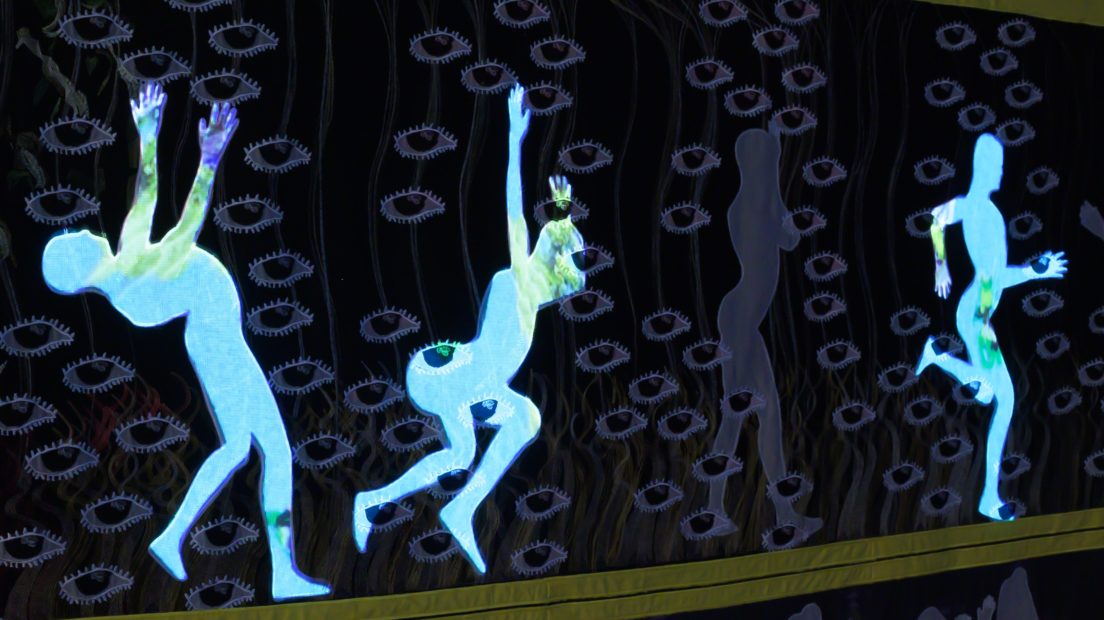
Is there an alternative to the binary system? The zeros and ones of digital code that echo the reductionist divide between male and female genders in Western cultures, between nature and culture, between organic and technologic, between us and them, as well as numerous other dichotomies? I long for ways of troubling or glitching these divides, as they too often cause damaging oppositions, produce static hierarchies and result in various modes of oppression.
In this article, I will explore the code used in digital computers alongside the warp and weft components of weaving. I take inspiration from mathematician Ada Lovelace (1815–52) and her groundbreaking innovation that would become the very first computer programme, alongside artists who, each in their own way, both cite and search for ways to transcend digital and other binaries.
While the histories and operational principles of coding and weaving seem unalike, they are closely connected. Weaving is traditionally considered a feminised activity and has, as such, been valued and remunerated less than other forms of labour, whereas computers are, still to this date, largely masculinised.
Often overlooked by history is the role of women recruited in the twentieth century as human computers to perform calculations on exponentially growing sets of data, including the calculation of artillery trajectories during World Wars I and II. The mechanical computations performed by women, as well as people of colour and other marginalised groups hired as computers, were considered dull, low-level activities, and workers were paid less than their male, white counterparts.1 Similar devaluations continue today for precarious labour remunerated way below minimum wage thresholds performed by crowdworkers, hired as contractors outside of federal laws protecting employees, who perform microtasks on demand on Amazon’s Mechanical Turk website – receiving its name from an 18th century chess ‘automaton’ in fact operated by a human chess master – and other platforms.
Consonantly, throughout Western art history, weaving has been belittled as a craft and diminished in comparison to art. Artist Hannah Ryggen (1894–1970), who lived and worked in Ørland, Norway, was one of the most inspiring voices questioning this divide between art and craft.
Revisiting Ryggen’s uncompromisingly feminist, antifascist and innovative tapestries in the context of Ada Lovelace’s invention, I will look at a number of artists’ work produced in relation to Lovelace, to ask what imaginaries we can conjure that undo dyadic divides for more complex, interwoven and equitable relations.
Ada
During nine months in 1842–43, Ada Lovelace developed what would become the very first computer programme. Through her privileged upbringing, Lovelace was able to overcome a societal barrier to women’s education, and particularly mathematics, science and technology, and develop a world-changing concept – code – from within precisely those fields.
In 1833, Lovelace had joined her mother to attend the presentation of a new machine created by inventor and engineer Charles Babbage. Called the Difference Engine, the apparatus was a mechanical calculator able to perform a series of operations with numerous variables, extract roots, raise numbers to the second and third powers, and store data for later retrieval.2 Lovelace understood the significance and beauty of the invention and began working with Babbage shortly after this encounter.
A decade later, Lovelace annotated her translation of the military engineer Luigi Menabrea’s commentary on Babbage’s newest invention, the Analytical Engine. This machine was a further development from the Difference Engine, designed to perform arithmetic operations based on punch cards.
Lovelace’s speculative discovery, as set out in her notes, was her understanding of the potential of the apparatus – an early computer – to go beyond arithmetic calculations. She realised that Baggage’s use of punch cards bore semblance to the cards used in Jacquard looms. In her annotations to Menabrea’s article, she wrote: ‘the Analytical Engine weaves algebraic patterns, just as the Jacquard loom weaves flowers and leaves.’3 While arithmetic includes operations on specific numbers through addition, subtraction, multiplication and division on top of some more advanced functions, algebra introduces abstraction and generalised rules for problem solving through equations and formulas including both numbers and unknown variables.
First conceived in 1801, the Jacquard loom enabled weavers to address each thread singularly and to programme the loom to perform equations that previously had to be carried out by the weaver. The punch cards inside the loom facilitated the production of complex combinations of warp and weft by working with simple commands composed of hole or no-hole, zero or one, enabling the weaver to automate the creation of elaborate patterns.
The Jacquard loom revolutionised the textile industry and Lovelace’s translation of the weaving mechanisms to a computer programme would change our world forever. Lovelace’s footnotes became the base for the binary code still used in computing today. She rewrote history quite literally from the margins.
Spinning and weaving Ada
Artist Ann Lislegaard has celebrated Lovelace’s legacy in the form of a multimedia installation consisting of various videos projected on to mirrored models stacked to form columns of different heights, depicting an animated spider weaving the mathematician’s name. The mirrors cut and replicate the image, throwing the glowing and moving green spider bodies and their reflected fragments on to the walls of the space as well as the viewers’ bodies.
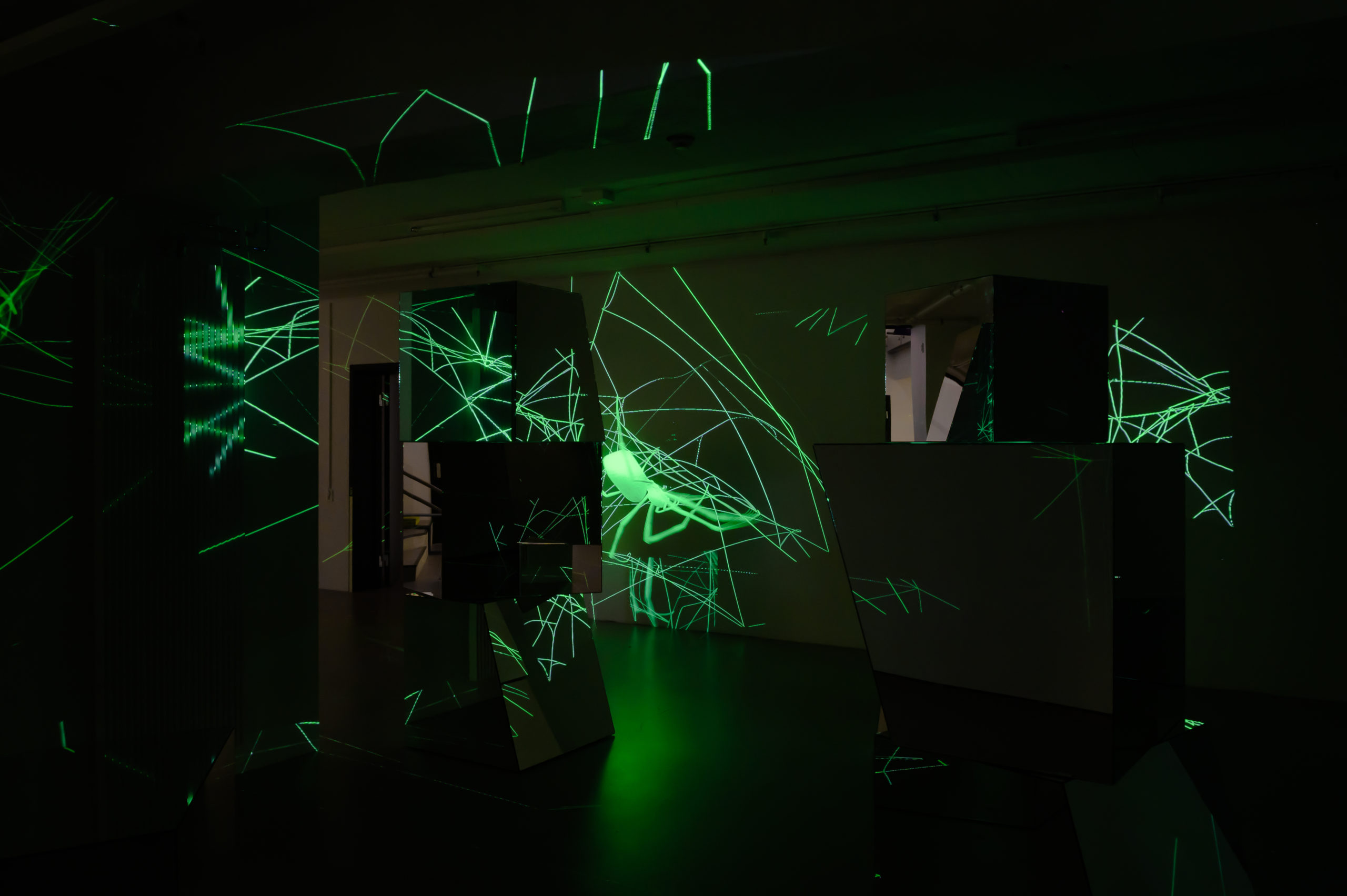
Titled Spinning and Weaving Ada (2016), the work conjures the Greek myth of Arachne, the Lydian weaver, who aroused the jealous wrath of the goddess Athena. Arachne challenged Athena to a contest, wherein the latter wove a masterful tapestry depicting the divine order of the gods, glorifying morals, decency, reason and law. Arachne’s work, even Athena had to admit, was splendid, but her chosen motif was a provocation. She depicted the Olympians’ excess, their abuse of power, their violation of women, but also mortal pleasures and indulgences. Angered by this insult, Athena punished her combatant, who, filled with shame, hanged herself. But the goddess relented and turned Arachne into a spider, suspended on a string and doomed, or blessed, to forever be weaving.
Critical studies researcher Sarat Maharaj suggests that Arachne’s tapestry, with its depictions of divine disgraces as well as bodily pleasures speaks of ‘tabooed desires, unchecked longings, feelings quite outside “the law”‘. Arachne’s disobedience and mockery of the gods called upon her Athena’s wrath as masculine corrective. Athena’s punishment seeks to uphold the established order, and to keep insubordinate women at bay.
The goddess’s simultaneous attraction to the superb weaving and repulsion of its quasi-orgasmic transgressions, Maharaj offers, is the masculine retort to femininity unbound, to crossing boundaries, to questioning the binaries of their clear demarcations. Lislegaard, in her dazzlingly engulfing installation, threads together Arachne’s overturning of tradition with Lovelace’s toppling of established gender roles.
Craft trouble
The gender binary propped up in weaving is bound up in numerous anxieties, including those of wage labour in capitalism. Shortly after the Jacquard loom was first introduced, and decades before Lovelace’s pioneering innovation, a secret organisation of English textile workers, the Luddites, destroyed machinery in factories in fear of their labour being replaced by mechanised work, with a peak of region-wide rebellions occurring between 1811–16.
The Luddites’ sentiments were connected to a societal fear of alienation and de-individualisation through the acceleration of modernity experienced at the time. Established identities were perceived to be under threat. Labour historian Kathleen Canning writes: ‘The textile industry posed unique dangers to masculine identity, [. . .] the mechanized textile mills symbolized “the problem of female competition in capitalism”: they were the first factories to make male workers superfluous, to “cast the Familienväter [fathers of families] into the streets.”’4 The mechanisation of labour threw questions of – masculinised – agency into high relief.
The question of agency is also at stake in the ongoing tension between art and craft. In the twentieth century, during the Bauhaus and continuing throughout Hannah Ryggen’s time, painting was considered the medium of individualistic expression of a rich interior life with true depth. Weaving, on the other hand, was thought of as a craft that, because of the intermediary of the loom, apparently lacked a clear subject, or an ‘I’. It was relegated to the domestic realm as devoid of thought and without ends. Indeed, Bauhaus artist Oskar Schlemmer wrote: ‘Where there is wool, there is a woman who weaves, if only to pass the time.’5
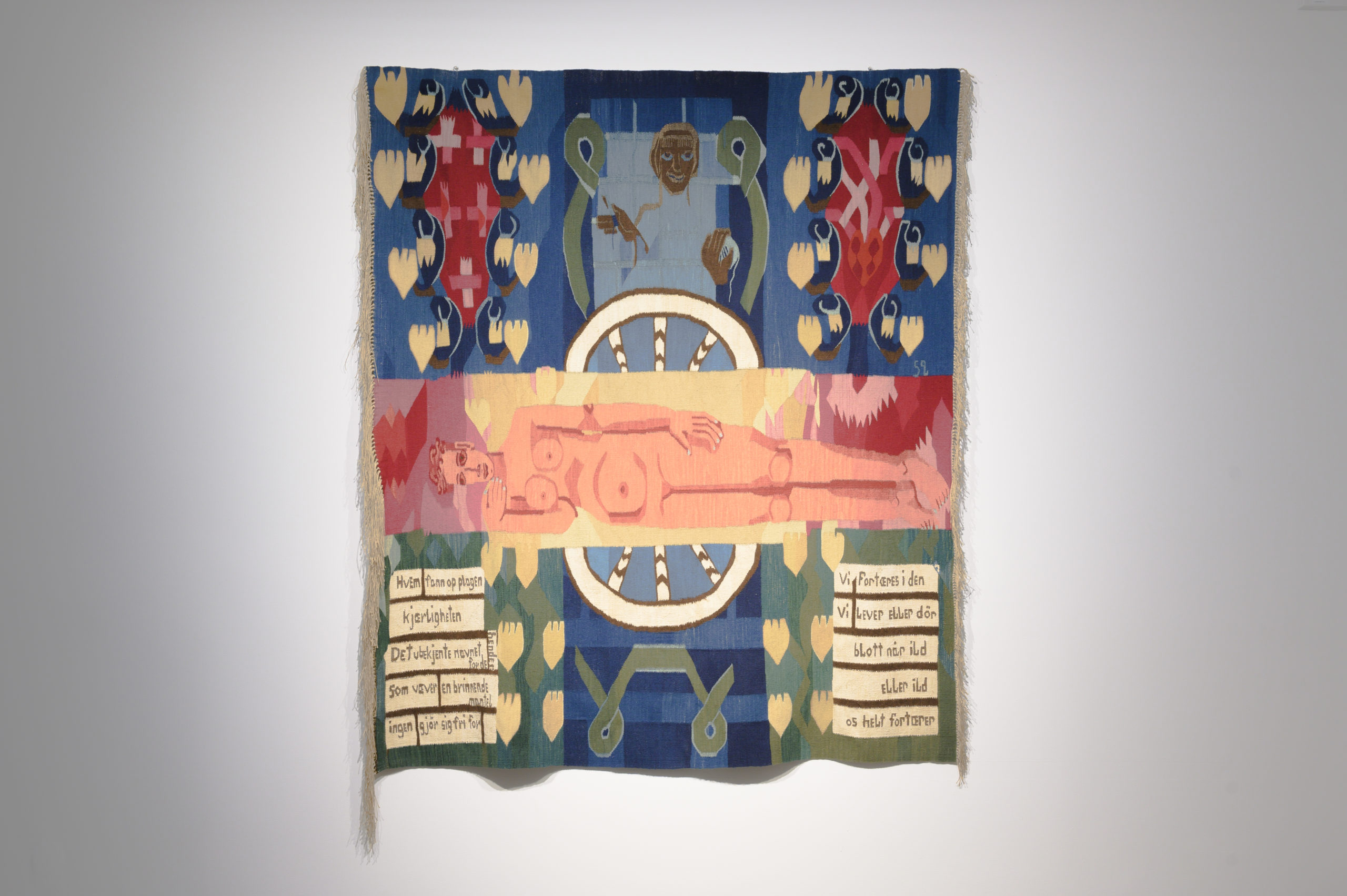
Even though she didn’t produce weavings mechanically, Ryggen, too, was affected by this devaluation and denounced the divide between art and craft. While Ryggen considered her tapestries to bridge the divide between art and craft, this quote elucidates the biases of her time, including her own, and the struggle for weaving – manual or machine-aided – to be recognised as art:
Just as a painter confronts a blank canvas, I believe the weaver ought to sit at the loom, without patterns, without other aids. Just as the painter from imagination on the canvas, I want the weaver to create the tapestry directly from imagination. Only then can weaving be art!6
Art historian T’ai Smith connects this hierarchy to notions of Western freedom. The European conception of freedom, as actualised in painting, depends on a direct and linear relationship between the body, the intellect and the tool (the brush). The agency of the weaver is put into question because the tapestry is created by the mechanics of the apparatus. The loom renders labour abstract and the maker passive – feminising and othering the weaver in multiple ways.
Weaving, and in particular mechanised weaving, puts into question values of human freedom – values that have been reserved for a few at the cost of people who are marginalised. As we see in colonial history and the decolonial struggles of racialised people, those rendered passive have been depreciated, pushed to the backgrounding sphere of the domestic, or situated as belonging to ‘primitive’ nature as opposed to culture. These backgrounds are both denigrated and at the same time necessary as a scene against which masculinised, patriarchal and colonial agency can unfold.
Various artists have complicated these simplistic oppositions. In recent work, Marilou Schultz’s tapestries combine Navajo weaving patterns and techniques with digital phenomena.
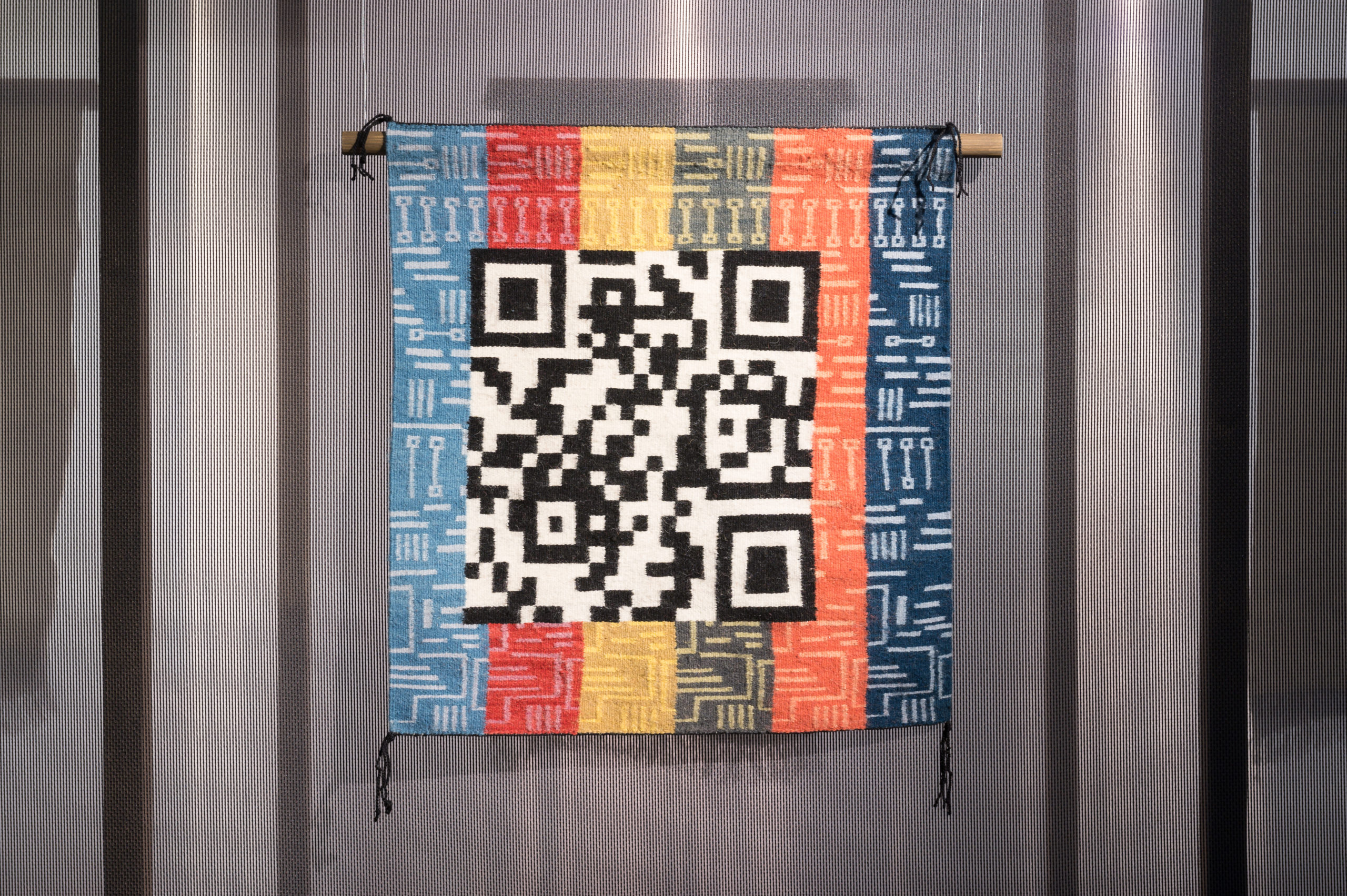
Vaimaila Urale fuses precolonial Samoan art forms and ASCII code to create large-scale textile works that explore storytelling.
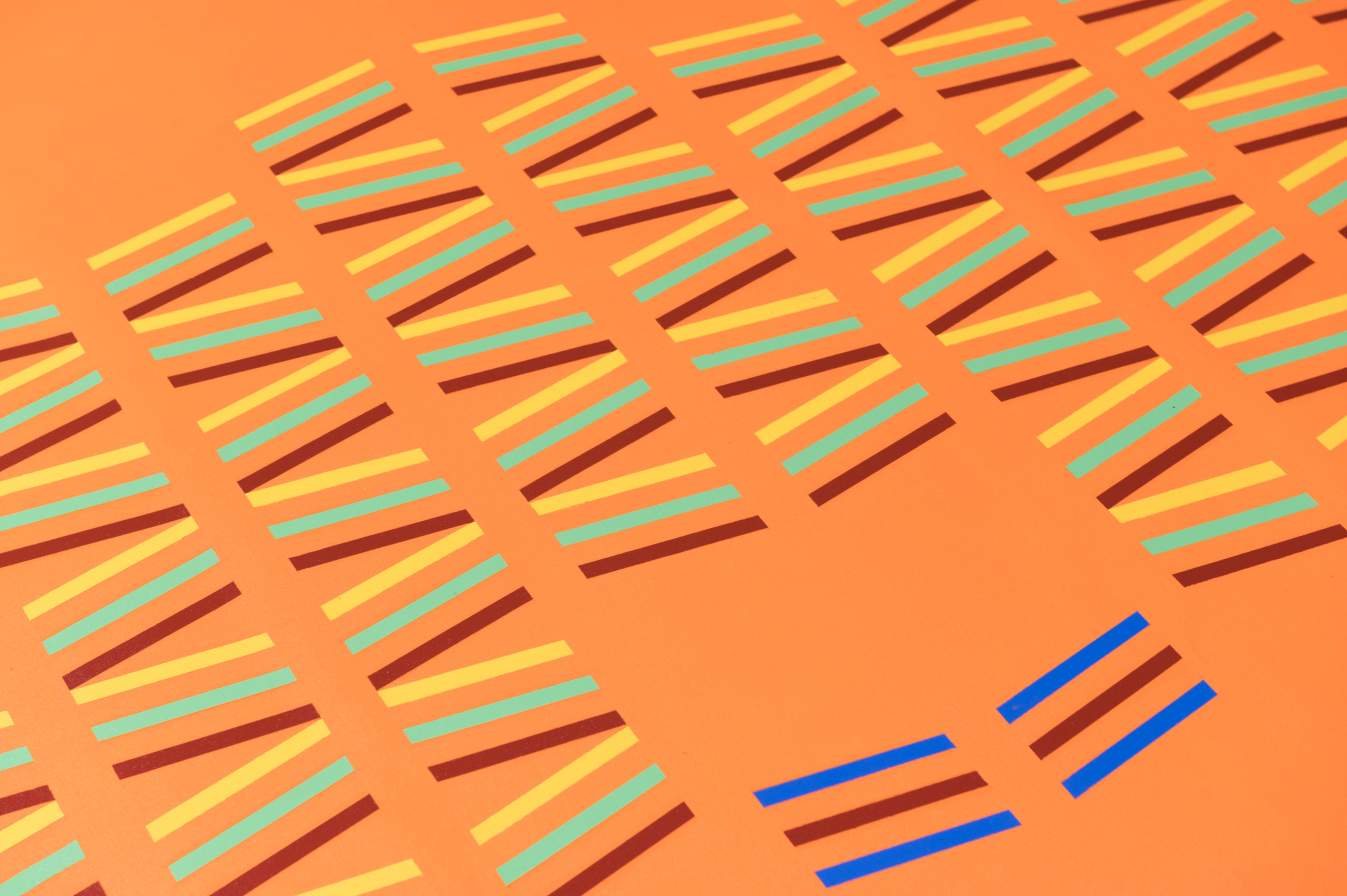
Thania Petersen’s tapestry Al Hurra (2019) appears to be dissolving, or burning, at the bottom. Part of a Muslim minority living in South Africa, she celebrates women who fearlessly defy categorisations.
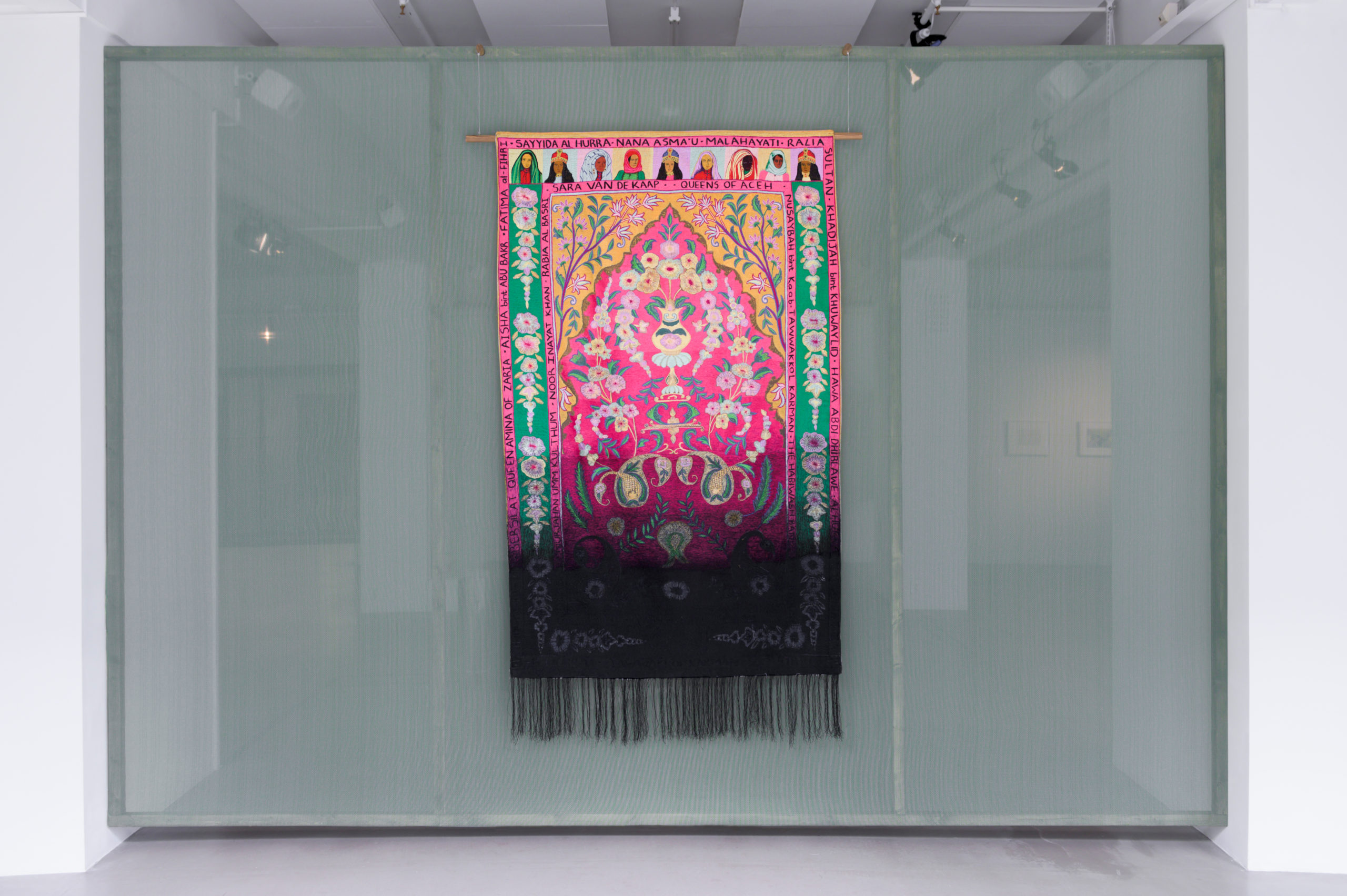
In another example, Mercedes Azpilicueta’s Jacquard tapestry speculatively narrates the voyages of a contested historical figure, the Basque nun Catalina de Erauso who adopted several male identities to travel to the New World. Rather than dissolving the contradictions of what – from today’s perspective – reads as progressive gender politics and Erauso’s role in colonial violence, Azpilicueta asks us to consider their unresolved, entangled coexistence.
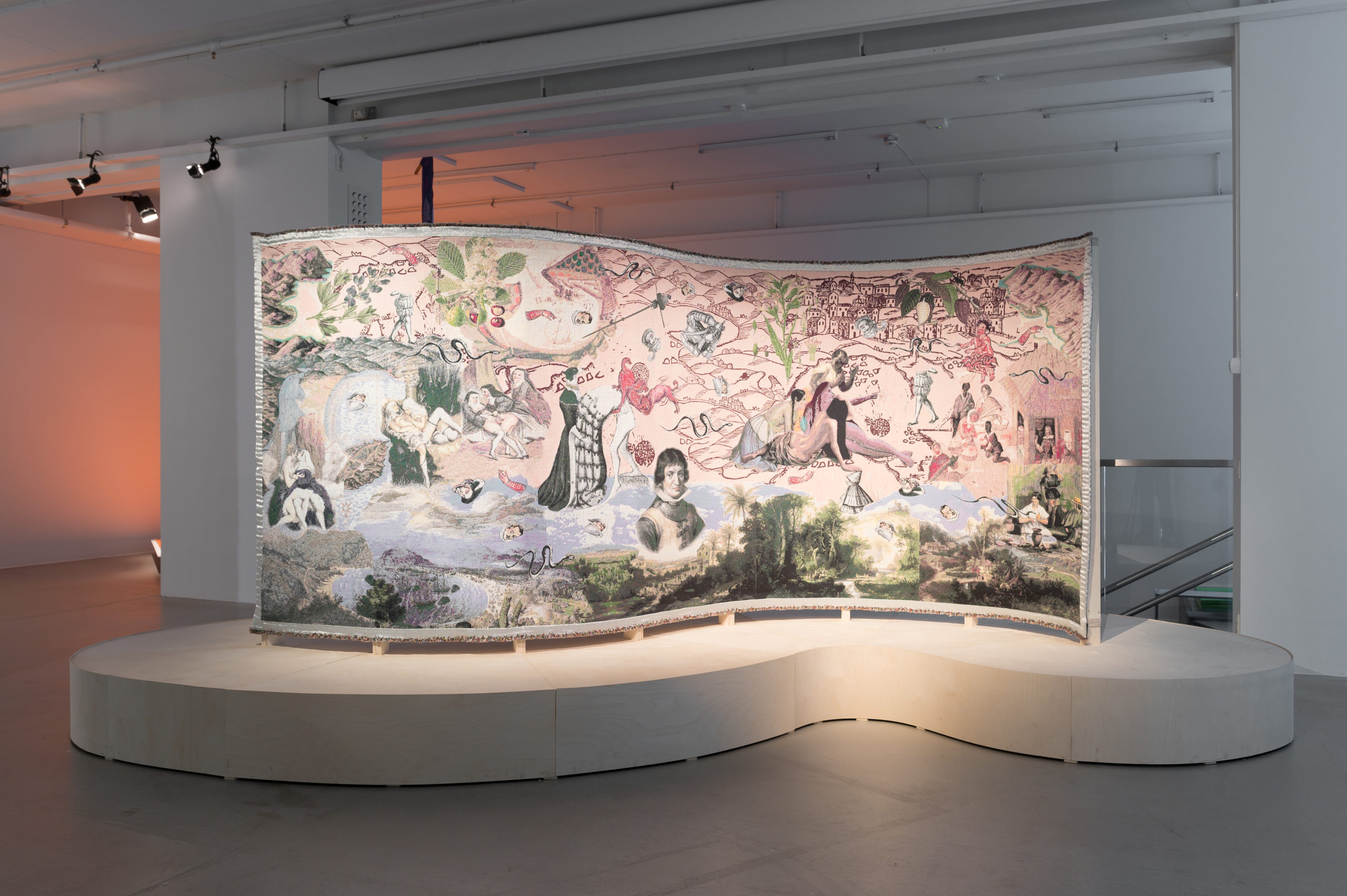
And finally, Himali Singh Soin’s Mountain, pixelated in the water (2021) is a monumental silk-cotton tapestry depicting the soundwaves of ice crystals. The textile incorporates the glitches of the used in Indonesia and India, and gestures to histories of trade, while connecting the forces of globalisation with climate change.
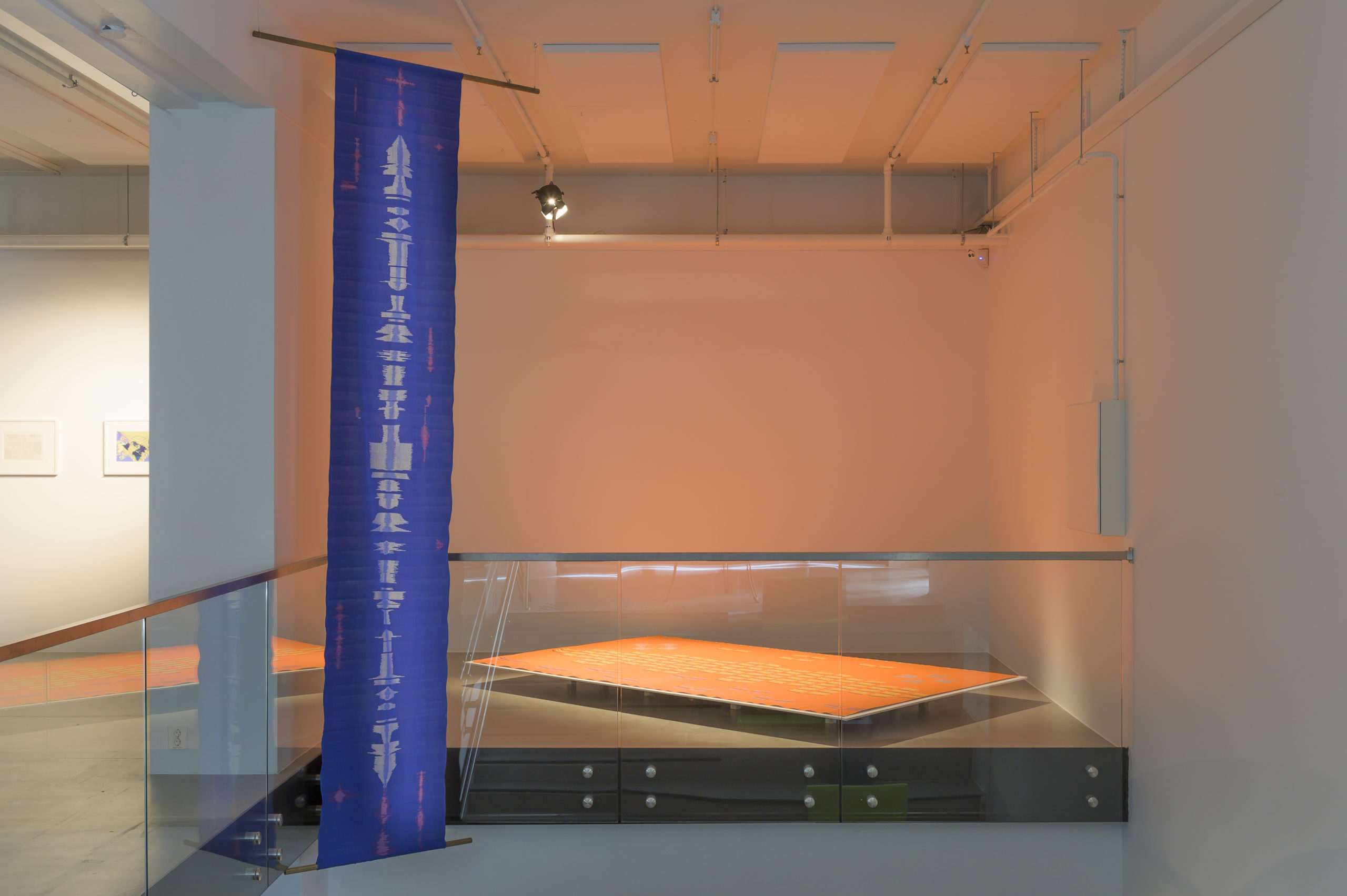
Anxieties of zero
Anxieties expressed in binaries permeate history. The introduction of rules to compute with zero by Indian mathematician and astronomer Brahmagupta in the seventh century CE, and Persian mathematician, astronomer and geographer Muhammad ibn Musa al-Khwarizmi’s work in algebra in the ninth century, produced great apprehensiveness in the Western world.
Algebra, unlike the Roman numerals then still forming the base of mathematics in Europe, enabled expressing complex numbers through just ten digits (0, 1, 2, … 9). The great invention of algebra, present also in the Jacquard loom, was the flexibility and simplification offered by articulating values by combining a number’s position with its specific value. This openness destabilised, or rather freed, signs of absolute meaning.
Concerning the introduction of zero, cultural theorist Sadie Plant suggests that it was considered a threat to the godly order, since to the Church, ‘one was everything and anything, first and last, best and good, universal, unified.’7 Ones, as holistic entities, were conceived as male and propped against zeros, which were devalued as lack and fundamentally female – a view perpetuated by psychoanalysis well into the twentieth century.
In the same year of Plant’s publication of Zeros + Ones, in 1997, artist Lynn Hershman Leeson wrote and directed the film Conceiving Ada. The adumbrative independent movie follows a computer programmer, played by Francesca Faridany, as she is creating a portal into a cybernetic past where she connects with Ada Lovelace, played by Tilda Swinton, as a chronologically impossible-to-situate version of the Victorian mathematician and programmer.
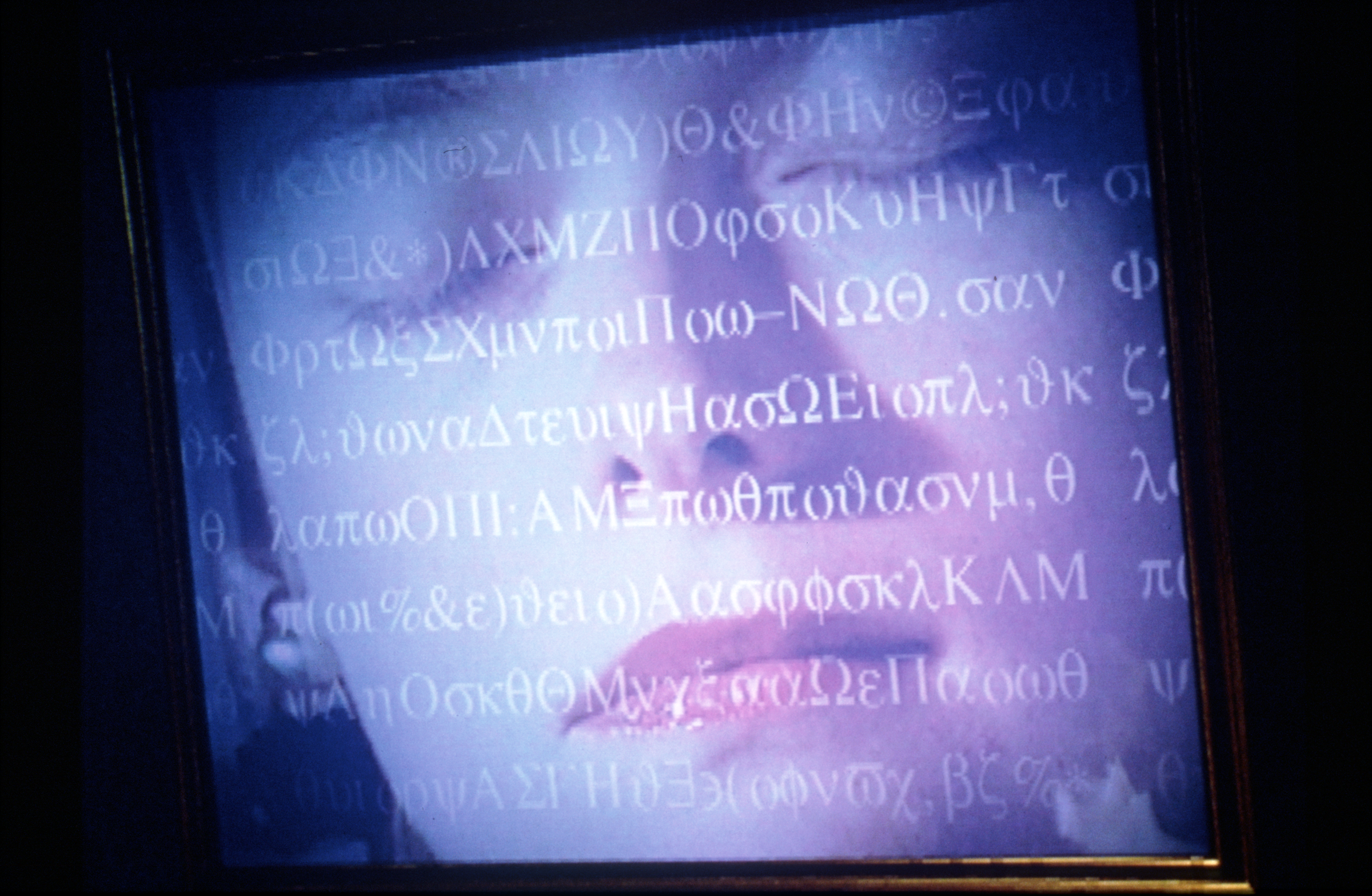
As Faridany’s character grapples with questions of motherhood and her career as a woman in science, she is becoming more and more immersed in the alternate universe of her creation, in which she can communicate with Lovelace. She tells Lovelace that she is able to see through her eyes and access her memory, which she achieves through a type of search engine, and tries to convince her to swap places so that all of her achievements will be fully acknowledged, three years in the future, or 1.5 centuries later for Lovelace. Lovelace – presciently? – refuses. And still today, Lovelace’s achievements are not fully recognised. Her contribution is a hole in history.
Paradoxically, both Jacquard punch cards and electronic systems turn the binary of ones as holistic and zeros as lacking around. A hole stands for a one and a blank represents a zero. A zero is also something.
Unweaving
Computer science researcher Letizia Jaccheri has observed that, while the binary code is an incredible invention allowing us to simplify and recombine disconnected entities, it is still just a translation.8 Like any model or rendition, code cannot fully account for the complexities of the world.
Moreover, computers are not only digital. In analogue computers, or organic systems, the binary as such does not exist. Our brains, unlike digital computers, send signals that only become effectual if they pass a certain threshold. It is a signal’s intensity that makes a synapse fire. Only when the chemical process is strong enough does it trigger a synaptic transmission, and it is only then, after the threshold has been passed, that a signal (versus no signal) appears. In organic computers, and perhaps in all systems, supposedly clear divides between zero and one, or between two genders, are auxiliary constructions. In these simplifications, the binary appears as truth, not as a framework with limitations and shortcomings.
Synaptic transmissions require intensities to be registered. In computing, glitches are moments of fervour that exceed the path pregiven by code. What, then, can we glean from such catalysing intensities? Realising the potential of glitches, curator Legacy Russell writes: ‘hacking the “code” of gender, making binaries blurry, becomes our core objective, a revolutionary catalyst.’9
Artist Tabitha Nikolai’s video game and installation, Ineffable Glossolalia (2017), pivots on her trans experience, which she describes as ‘in between, in flux, as occupying no fixed position.’ Nikolai invites users to navigate a virtual 3D narrative set inside the architecture of the simultaneously progressive – and, in its support of eugenics, extremely problematic – German Institut für Sexualwissenschaft (1919–33), which was targeted by Nazi youth brigades during the book burnings.
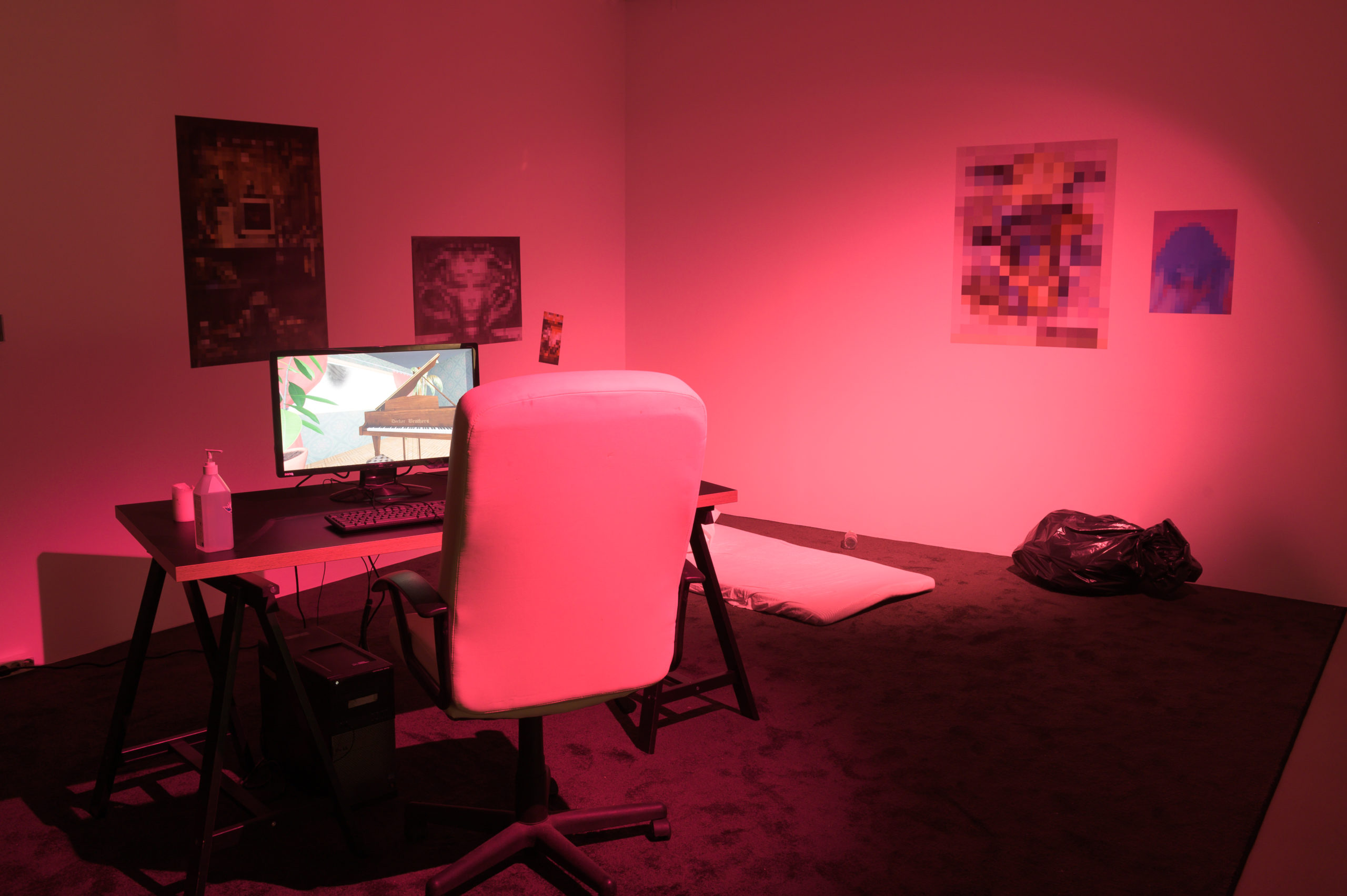
Danielle Brathwaite-Shirley’s work combines a large-scale tapestry and motion-capture video game, glitching gender binaries while centring on Black trans identities. Figures lit up by projected light appear to be moving across the large-scale tapestry, while dozens of eyes brighten up as watchful presences that could be either exposing or protective, spectacularising or witnessing. Alternately illuminated text fragments read ‘resisting erasure,’ ‘a Black memory has resurfaced,’ or ‘I will wear my identity and history on the surface so no one can ignore my truth.’
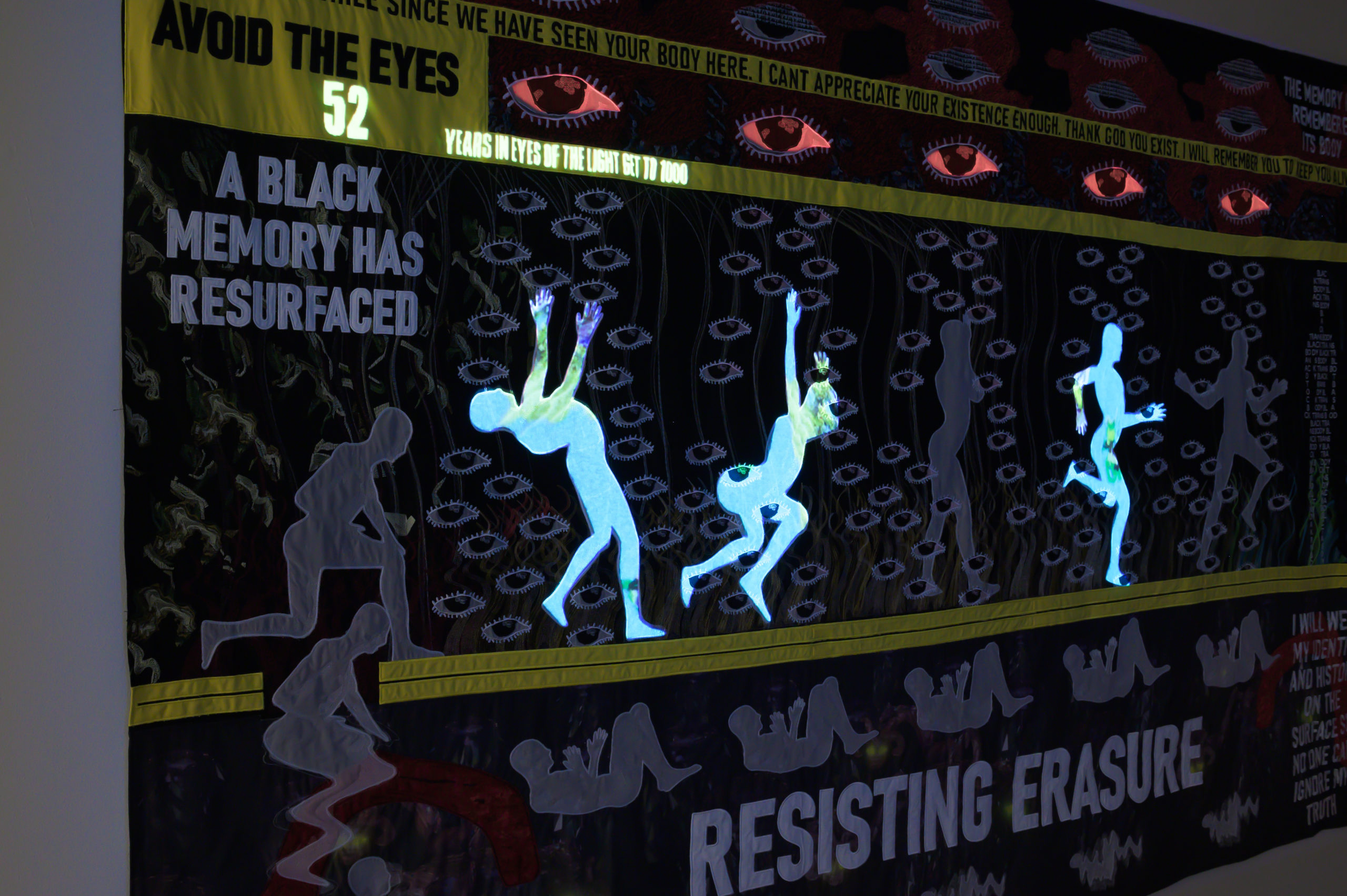
Brathwaite-Shirley’s work creates archives as repositories and havens for Black trans people and their stories. When entering her video games, which are designed with other Black and trans programmers, users are asked to respond to questions that establish the rules of engagement and remind us of the ways in which white supremacy and heteropatriarchy condition analogue and digital worlds. But Brathwaite-Shirley’s prompts also create modes of resistance. Her work dissolves dichotomies and asserts both identity and fluidity, while not only demanding the resistance of erasure of Black trans pasts and presents, but creating spaces to flourish and thrive.
It was Lovelace’s unignorable invention that ushered in the digital age. It was Ryggen’s fierce defiance to established categories that secured her place in art history. It is the decolonial resistance to damaging categories of nature and culture, us and them, that is creating paths for more sustainable futures. It is through the uncompromising disavowal of gender binaries, by those who philosopher and curator Paul Preciado affectively calls beautiful ‘monsters’, that we can overcome the heteropatriarchal oppressions producing the psychological and social costs of ‘anxiety, hallucination, melancholy, depression’,10 and more.
A tapestry, even if it is composed of threads organised as warp and weft, comes into existence as a woven entity through bonds that do not exist apart. Cannot be thought apart. Ada Lovelace knew this when she wrote: ‘All, and everything is naturally related and interconnected. A volume I could write on this subject.’11 Ryggen celebrates this sense of unity and the intensity of love in her work, Dikt av T. S. Eliot (1952, Poem by T. S. Eliot).
These intensities have the power to produce glitches in established genres and binary divisions. They throw out of joint ‘handed-down notions of art practice/genre/gender’12, as Maharaj writes of avant-garde textile practice. Might we, engendering intensive new imaginaries through glitches, not only overturn binaries, but rid ourselves of ostensible divides altogether? Let us unweave the binary system!
This article draws from the curation and artworks exhibited in Unweaving the binary code, which co-curated by Stefanie Hessler and Katrine Elise Agpalza Pedersen at Kunsthall Trondheim, within the framework of the Hannah Ryggen Trienalle, a recurring exhibition organised every three years in Norway in honour of the feminist artist working mostly in tapestries, Hannah Ryggen (1894–1970).
Artists in the exhibition included: Mercedes Azpilicueta (Amsterdam, Netherlands/Buenos Aires, Argentina), Charlotte Johannesson (Skanör, Sweden), Ann Lislegaard (Tønsberg, Norway/Copenhagen, Denmark), Tabitha Nikolai (Portland, Oregon, USA), Allison Parrish (New York, USA), Thania Petersen (Cape Town, South Africa), Pearla Pigao (Oslo, Norway), Hannah Ryggen (Ørland, Norway), Marilou Schultz (Mesa, Arizona, USA), Danielle Brathwaite-Shirley (London, UK/Berlin, Germany), Himali Singh Soin (London, UK/Delhi, India), Vaimaila Urale (Avondale, Tāmaki Makaurau, New Zealand).
We are grateful to the artists for permitting us to reproduce their work.
- David Alan Grier, When Computers Were Human (Princeton: Princeton University Press, 2007).
- The full Difference Engine would have been room-size but was never built. The version presented in 1833 was a smaller working model one-seventh the size that the full machine would have been.
- Luigi Menabrea, Sketch of the Analytical Engine invented by Charles Babbage (1843), translated and annotated by Ada Lovelace, Note A.
- Kathleen Canning, Languages of Labor and Gender: Female Factory Work in Germany, 1850-1914 (Ann Arbor: The University of Michigan Press, 2002), 3–4. Canning quotes Robert Wilbrandt, Die Weber in der Gegenwart (Jena: Gustav Fischer, 1906), 1; 124.
- Oskar Schlemmer quoted in T’ai Smith, Bauhaus Weaving Theory: From Feminine Craft to Mode of Design (Minneapolis and London: University of Minnesota Press, 2014), xxvii.
- Hannah Ryggen quoted and translated from “Kvinner og hjem. Nye veier i vevekunsten. Ikke mønster og kopiering, men skapende fantasi,” Adresseavisen, May 3, 1930, in Marit Paasche, Hannah Ryggen: Threads of Defiance (London: Thames and Hudson, 2019), 34.
- Sadie Plant, Zeros + Ones: Digital Women + the New Technoculture (London: Fourth Estate, 1997), 54.
- In a meeting with the author on 15 November 2021.
- Legacy Russell, Glitch Feminism: A Manifesto (London and New York: Verso, 2020), 25.
- Paul B. Preciado, Can the Monster Speak? (London: Fitzcarraldo Editions, 2021), 53.
- Lovelace quoted in Plant, Zeros + Ones, 11.
- Maharaj, 77.
Related content
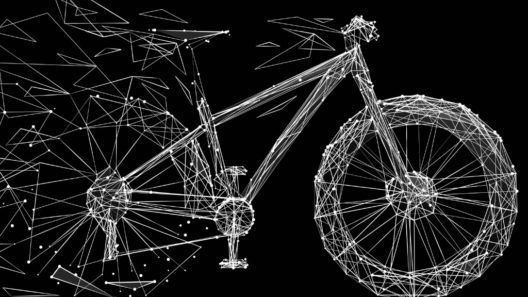
Mobilising the intellectual resources of the arts and humanities
Challenging and redrawing framings of technology to serve human flourishing and justice
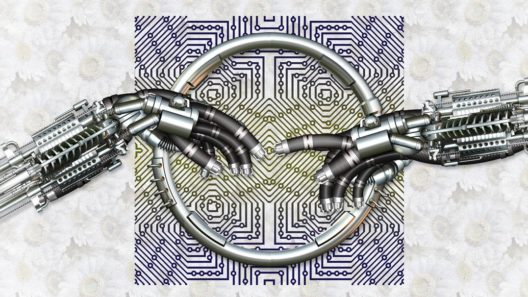
The role of the arts and humanities in thinking about artificial intelligence (AI)
Reclaiming a broad and foundational understanding of ethics in the AI domain, with radical implications for the re-ordering of social power
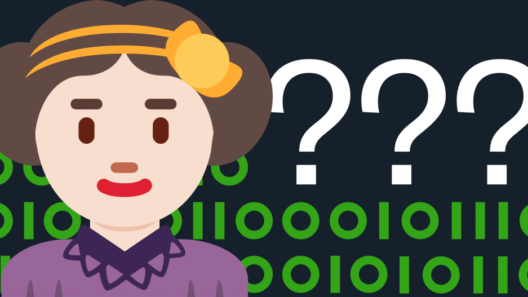
What does Ada Lovelace mean to you?
Celebrating Ada Lovelace Day 2020 with six women computer scientists.

Celebrating Ada Lovelace Day: what Ada means to us
Celebrating the contribution to global culture of a remarkable woman: a curious visionary, poetical scientist and collaborative thinker.